dduelin
Site Supporter
When you have a new sprocket to hold against a used sprocket the tooth wear is more apparent.
Follow along with the video below to see how to install our site as a web app on your home screen.

Note: This feature currently requires accessing the site using the built-in Safari browser.

Hahaha I like to get in the rough. I thought some might mention the grime.The photo is very grainy so I personally can’t see enough detail regarding the sprocket. Will say I’ve never had a chain that looks as dirty as that on any of my bikes, but I’ve rarely ridden any of them off road.
I measured the slack and I think it is about 3 quarters of an increase if I remember correctly.Could just be me, but that chain looks like it's a little on the tight side. Hard to tell.
I'm going to assume you mean 3/4 of an inch? If so, def too tight. On the bottom side of the chain and in the middle between front and rear sprockets, you should be able to push down on the chain and then lift up toward the swing arm and there be about 1.5" between the two points.I measured the slack and I think it is about 3 quarters of an increase if I remember correctly.
I have a nc700s and the manual says between 25mm and 35mm, what you are suggesting is more than 38mm?I'm going to assume you mean 3/4 of an inch? If so, def too tight. On the bottom side of the chain and in the middle between front and rear sprockets, you should be able to push down on the chain and then lift up toward the swing arm and there be about 1.5" between the two points.
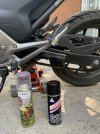
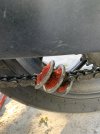
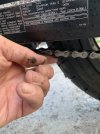
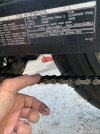
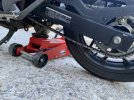

Ok so took some measurements cleaned the chain and oiled the chain. So I am a little heavy on the oiling as I’m thinking I do not want a dry chain lol I’m a rookie when working on my bike but getting some solid advice from this site as you may note from my Jack stand for cleaning and oiling. Took some more photos to add. Thanks again fellow NC riders.
The 1100 has a larger 530 chain with larger sprockets to fit. It's not accurate comparison to the smaller 520 NC700 chain set but it's why some of us have swapped to a 525 or 530 chain/sprocket set in search of longer wear. Spark plugs on the NC are R & R at 32,000 miles. If one rarely sees 3500 rpm it stands to reason Honda's service intervals are extremely conservative on plugs and valves. Air cleaners, valve checks, oil filters..... plenty of people stretch service intervals. I do check valves pretty much on time and track needed adjustments if any. When I'm satisfied that stretching the interval carries little risk I stretch them but without the history it's only a guess. On the other hand some things carry a lot of risk even at the manufacturer's service recommendation. We both owned ST1300s and they have a 12,000 mile or 24 month brake fluid replacement schedule. Lots of owners that pile up miles check the brakes annually or at 12,000 miles and still do frequent checks of the rear brake. That brake system is intolerant of neglect and spinning the rear wheel now and then to check rear brake drag is a pretty good thing to do.But exactly how much sprocket wear is detrimental?
If you ride 1,000 miles there is bound to be some wear. If you ride 5,000 miles there is more wear. If you ride 10,000 miles there is bound to be even more wear. But how much wear is detrimental?
Will the OE sprockets last as long as two OE chains?
The first chain and sprockets on my 2014 CB 1100 went 36,909 miles before I changed them out together. The replacement set now has almost 33,000 miles on them. OE chain and sprockets both times. Are the OE sprockets on the CB made of better steel than the OE sprockets on an NC ? Are the OE chains better on one than on the other? (both DID oring chains). I don't know but imagine the OE sprockets on the NC will last as long as 2 OE chains considering what I have read on this forum about the life span of an OE chain. My OE chain has 16,000 miles on it currently. When the chain hits the red band on the swingarm I will take a look at the sprockets and determine at that time if I think they are good enough to last another chain. I expect some wear would be evident when compared to a brand new set of sprockets but again how much wear is detrimental? And how detrimental?
To give you another example.. spark plugs. Honda says to replace spark plugs at what 16,000 miles? I assume because of wear on the electrode and ceramic. Yet 670cc has stated he has 60 something thousand miles on his plugs and plans to take them to 100,000. Shouldn't he have replaced his plugs 3.75 times by now due to wear?
Air cleaners..... who replaces them at 12,000 miles? (I usually replace mine at 25,000 on my other bikes)
Valve adjustments ...... who checks them every 16,000 miles?
Personally, I would have never imagined you could get 8,000 miles out of dino oil and 16,000 miles out of oil filters but following Hondas recommendation I did just that. I would have normally replaced both at 4,000 mile intervals. I have read guys online that boast that they change their oil/oil filters every 1,500 miles. (I have a buddy that changes the oil in his 2021 car every 2,500 miles even though it calls for it every 7,500 miles)
Another old motorcycle story from the 70's...working at a Yamaha shop. We'd have guys bring their dirt bikes in saying the motors would start, the bikes would go into gear, but when they let out the clutch, then they wouldn't go anywhere. Inspection showed front and rear sprockets no longer had teeth, only nubs. and the chains no longer had anything to grip and would just spin on the nubs therefore the bike wouldn't go anywhere.
Now THAT much sprocket wear was detrimental lol.
The OEM spark plugs are iridium plugs. The NGK web site says they should be good for 70,000 miles. I guess Honda has nothing to lose by recommending early plug replacement, and nothing to gain from recommending a long replacement interval.The 1100 has a larger 530 chain with larger sprockets to fit. It's not accurate comparison to the smaller 520 NC700 chain set but it's why some of us have swapped to a 525 or 530 chain/sprocket set in search of longer wear. Spark plugs on the NC are R & R at 32,000 miles. If one rarely sees 3500 rpm it stands to reason Honda's service intervals are extremely conservative on plugs and valves. Air cleaners, valve checks, oil filters..... plenty of people stretch service intervals. I do check valves pretty much on time and track needed adjustments if any. When I'm satisfied that stretching the interval carries little risk I stretch them but without the history it's only a guess. On the other hand some things carry a lot of risk even at the manufacturer's service recommendation. We both owned ST1300s and they have a 12,000 mile or 24 month brake fluid replacement schedule. Lots of owners that pile up miles check the brakes annually or at 12,000 miles and still do frequent checks of the rear brake. That brake system is intolerant of neglect and spinning the rear wheel now and then to check rear brake drag is a pretty good thing to do.
Thanks looks like I am a little tight. I will take some metric measurements tomorrow. Maybe loosen off just a little.So what is the slack set at (in mm)? Your picture showing the upper position makes it look a little tight, but maybe it’s because of the jack that simulates a center stand. Honda specs call for chain slack measured while the bike is on the sidestand.
My quick check is when on the sidestand, the forced upper check position, at the rear of the swingarm chain guide (which is about midway between sprockets), the chain almost, but not quite, touches the swingarm.
Your comments exemplify motorcycle chain final drive ownership. It‘s an annoyance, a nusiance, a maintenance expense, and a waste of time. If the chain frustrates you, you’re probably not alone. Belt drive and shaft drive are out there in the motorcycle world, but Honda is using chain drive on the vast majority of it’s models. Currently, less than half of our motorized two wheel fleet is chain drive, and if possible, I hope to avoid any more chain drive purchases.Sometimes I think I worry about the chain too much. Rode home from work in the pouring rain. The bike is filthy, but the chain is as clean as when I just washed it and lubed it last week. There seems to be even more kinks in the chain than there was before. I’ve got a brand new chain, I’m tempted to just swap it out, but that kind of feels wasteful. I will say I am kind of pleased with the ATF as a lube, I’ll have to perfect my application technique, but I’ve got a gallon of the stuff, so why not use it?
Everyone uses mileage based interval because it’s possible to damage the fine electrode by checking it. Not that you shouldn’t check it it’s just possible. 70,000 miles is conservative for an iridium plug. Ngk makes a damn good plug, though it pains me to say it, and I have seen automotive plugs go for over 100,000 miles no problem.The OEM spark plugs are iridium plugs. The NGK web site says they should be good for 70,000 miles. I guess Honda has nothing to lose by recommending early plug replacement, and nothing to gain from recommending a long replacement interval.
I look at the Honda’s recommended service intervals as a guide, then I adjust according to experience. Some intervals get lengthened, some get shortened based on actual experience. When I check the original spark plugs at 64,000 miles, if the gap is outside spec, they get replaced. If the gap is within spec, the plugs go back in the engine.
Back on the thread topic of chains, Honda recommends replacement when they wear out, according to the wear indicator. I don’t know why Honda doesn’t use plug gap measurement as a wear indicator, instead they use a mileage based replacement interval.
I agree, compare the old sprocket to a new one. So today I had my rear wheel off and I unbolted the rear sprocket from the carrier. I placed the 61,281 mile original sprocket against a new Superlite sprocket and I could not detect significant wear. So I made the logical choice and put the bike's original rear sprocket back on the wheel. Maybe at the next tire change around 70,000 miles, I’ll replace the original sprocket; who knows?When you have a new sprocket to hold against a used sprocket the tooth wear is more apparent.
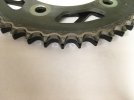
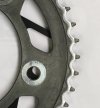
I agree, compare the old sprocket to a new one. So today I had my rear wheel off and I unbolted the rear sprocket from the carrier. I placed the 61,281 mile original sprocket against a new Superlite sprocket and I could not detect significant wear. So I made the logical choice and put the bike's original rear sprocket back on the wheel. Maybe at the next tire change around 70,000 miles, I’ll replace the original sprocket; who knows?
Pictures show a 10 year old, 61,281 mile sprocket aligned on top of a new sprocket. The owner’s manual says to change the sprocket when it is worn or damaged, but apparently it’s not. The commonly heard advice of changing sprockets at every chain replacement, or even every other, seems to be sometimes way over the top wasteful.
It also occurred to me that for convenience, the best time to check and/or change a rear sprocket is when you change the rear tire and you have the rear wheel off anyway, not necessarily when you replace the chain.
View attachment 50066View attachment 50067